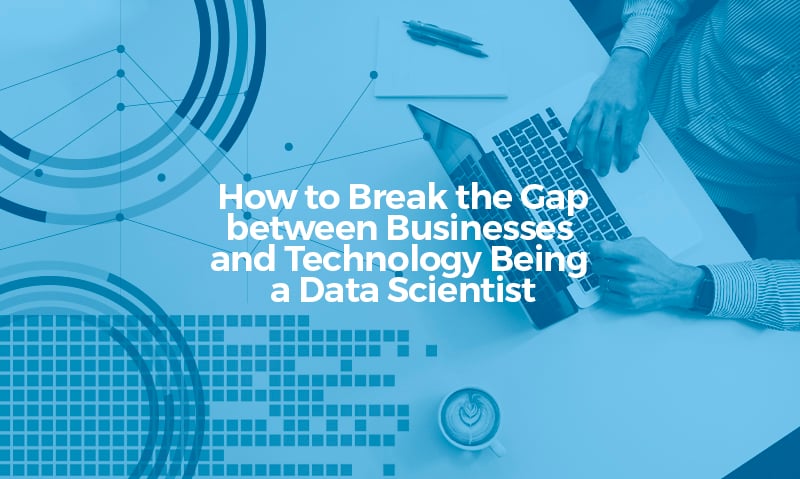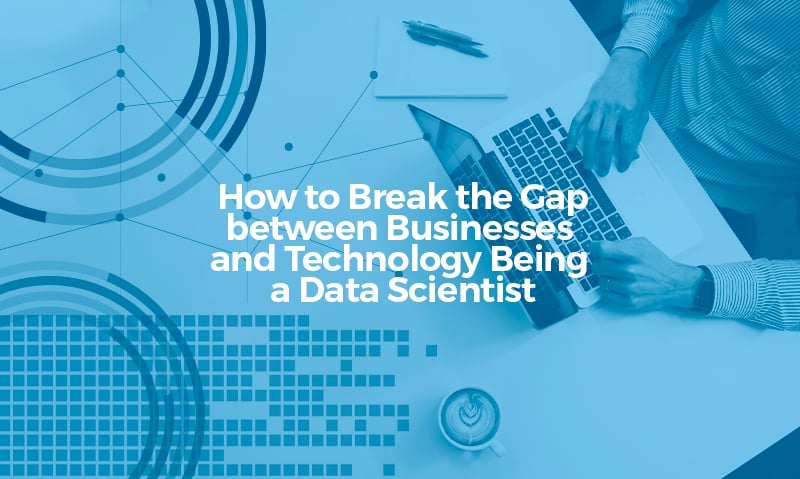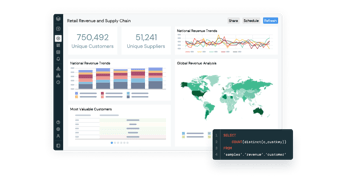What makes a data science career so unique? In our article we explore how to break the gap between business and technology.
Whether you are fresh on the heels of your data science Bachelor’s or Master’s degree or have extensive experience in the field of data science, it can be difficult to bridge the gap between your skills and the work environment you operate in. According to Data Science Central, 40% of data scientists on the global level are employed by Fortune 500 companies, with predominant industry choices being IT (43%), industrial (39%) and finance (16%).

Given that data scientists can fit into a multitude of niches and companies thanks to their versatile skillsets, it can sometimes be tough to successfully adapt to employer expectations and fit into the team seamlessly. While onboarding, startup environment or senior data scientist mentorships might not always be an option, the right mix of business-oriented and technology-centric activities on your part will allow you to become a part of the company quite easily. With that said, let’s dive into what makes data science so unique as a career choice and how you can break the proverbial barrier of being unable to bridge the gap between business and technology.
Data Science and Its Role in Business and Technology
Before we dive into the intricacies of fitting between business and technology as a data scientist, let’s take a look at what makes this career path so unique. Brian Mitchel, Head of Business Management at Studicus had this to say on the topic: “Whether you run an eCommerce business or a cloud-based services website, having a data scientist on board is essential for your everyday success. Their mindset and mix of soft and hard skills allow them to assist your projects in a number of meaningful ways as long as they feel like an organic extension of your team.”
Modern data scientists are required to not only be familiar with coding languages such as Python and SQL but also with a variety of business-centric skills such as problem-solving and strategic thinking. In addition, data scientists are often required to create or modify machine learning algorithms such as chatbot AI and to be familiar with basic visual art design and presentation principles.
In short, modern data scientists are all-around project managers, developers and coders in one, making them a jack of all trades. Now that we have a better understanding of how data scientists can fit into a plethora of roles and job descriptions in a variety of niches, let’s take a look at some concrete ways in which they can contribute to day-to-day operations in their business environments.
Shared Business Goals
Just like professional programmers, content creators or visual artists, data scientists should be familiar with business goals, mission statement and long-term vision of your company. As we’ve mentioned before, data scientists can often function as team leads and project managers due to their mixed set of skills which combines a number of niches under one roof.
This makes them perfect for leadership grooming and their familiarity with your business goals, principles and client etiquette is extremely important. It will allow them to successfully break the gap between the business side of your company while also contributing to its goals with their technological, coding and data science skills.
Meaningful Team Collaboration
It is pivotal for your business, regardless of its scale or industry, to be a team-oriented entity. This rule should apply for every employee on your roster, whether they sometimes work from home or like to delegate duties to others. Lory Duval, Head of HR over at WoWGrade spoke on the matter briefly: “As much as we sometimes like to be left alone at work, we still need to function as a whole for the betterment of the company as a whole. Whether through team-building activities or redesigned job descriptions, employees should always be encouraged to communicate, collaborate and share in their successes and failures as a team.”
Data scientists are, due to their familiarity with in-depth computer science and data analytics, confined to individualized job descriptions and positions. This can create an artificial gap between them and the rest of the team – which is something you should avoid at all costs.
Data Privacy Measures
The best way to bridge the gap between business and technology when it comes to data scientists and their skillsets is to find a meaningful way for them to contribute to the company as a whole. One such way can include them being in charge of your business’ data privacy policies, software and management.
Digital threats in the form of malware, hacking intrusions and social engineering exploits can dampen your business’ growth and reputation considerably. A data scientist is able to place protective measures in place and collaborate with their coworkers with the intent to stop these incursions from happening. This will not only allow them to keep the cyber security aspect of your company under constant control but also bring them closer to the office floor and require everyone to constantly communicate and work together on data privacy.
Machine-Learning Processes Integration
Depending on the type of company you run, data scientists can implement a number of machine-learning processes into your business strategy on the fly. For example, the most obvious machine-learning addition to your company could be to introduce chatbots and conversational AI into the customer experience segment of your client outreach.
Likewise, data scientists can create and manage a plethora of algorithms that can speed up manual data gathering, analysis or processing in vain with your product or service portfolio. This type of contribution to your business model will be seen as positive and advantageous by your employees which will see the significance of data science and technology in day-to-day workflow more clearly.
Visualized Statistical Data
Lastly, one of the best ways for data scientists to bridge the gap between their technological skills and business-centric office activities is through data visualization. Data science job descriptions often revolve around data extrapolation, analysis, coding and data management which can be abstract terms to employees without the necessary know-how.
However, data scientists can implement their visual and artistic skills to create data presentations, infographics and charts of relevant information for their coworkers after the relevant analysis is done. This will make it easier and quicker for everyone to understand and implement the work done by data scientists and place an even larger emphasis on collaboration in your company.
The Best of Both Worlds
It is an undeniable fact that technology and business have become inseparable parts of successful corporate development. While it may seem daunting at first, integrating data science specialists into your company can bring a multitude of long-term benefits to your business.
Given their versatile nature, data scientists will be able to implement their skillsets into any number of departments or positions depending on your current needs and bottlenecks. Over time, both them and their colleagues will see the significance of collaborative workflow and the proverbial gap between business and technology in your company will become an afterthought.
Estelle Liotard is a Senior Writer at Trust My Paper and an Editor at Grab My Essay, respectively. In addition, Estelle is a frequent contributor at Supreme Dissertations where she continues to hone her writing and digital publishing skills. She is an experienced content creator and a writer who excels in AI-related topics with an emphasis on its practical business applications. In her spare time, Estelle enjoys quiet afternoons on her balcony and cooking.



